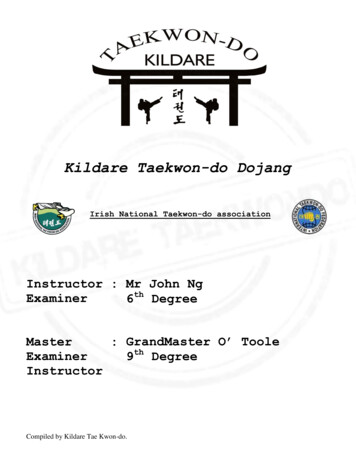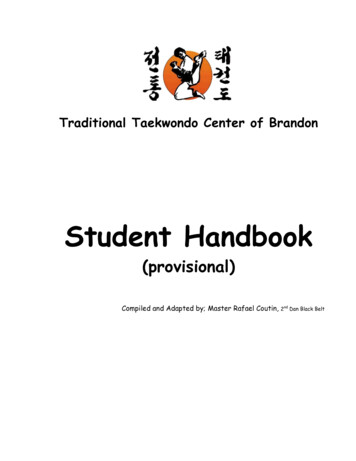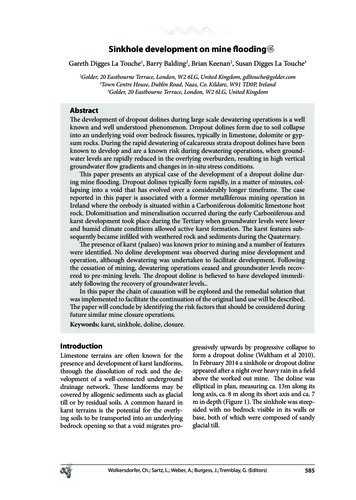
Transcription
Kildare Taekwon-do DojangIrish National Taekwon-do associationInstructor : Mr John NgExaminer6th DegreeMaster: GrandMaster O’ TooleExaminer9th DegreeInstructorCompiled by Kildare Tae Kwon-do.
Rules for Taekwon-Do Dojang & Student1. Students must obey and respect their Instructors, Parents, Teachers and Senior Ranks. Theyshould bow and greet the Masters and Instructors whenever, wherever they meet. Mastersand Instructors must be addressed by their last name (e.g. Master O’Toole, Mr. Ng.etc.).When you have a conversation with them, you should address "Sir" or "Miss" at the end ofeach sentence.2. Please arrive on time or earlier to stretch in order to prevent injury. Late arrival studentsshould wait at the entrance and will be asking to do their stretching before joining the class.3. Wear a clean and tidy uniform before entering the dojang. Students should tie up their longhair or use a headband for medium long hair.4. Bow to the flags, then instructors according to their ranking when entering and exiting thedojang.5. Students should not enter or leave the class without obtaining permission from Masters orInstructors.6. To show respect and considering the safety of the class, during the class, parents and othersshould stay in the viewing area and should not enter the dojang unless you are invited by aninstructor. If you have any question, our instructors will be available to assist you.7. Line up according to the ranking from the right to the left and the front row to the back. Latearrival, not complete or without a proper uniform should line up to the back whatever theirranking.8. No shoes except the Taekwon-Do training shoes are allowed in the dojang.9. To prevent injuries, jewelries and watches are not to be worn during training. Finger and toenails should be kept short. Students with long nails are not allowed to participate in anysparring or target training.10. Food, alcohol, tobacco, chewing gum, loud conversation, negative behavior and foullanguage are strictly prohibited in the dojang.11. Seniors must behave and set a good example for the juniors.12. Students should always practice at home and try to memorize their patterns before theycome to the class. Considering the progress of the class, a special training group in the classwill be available to assist the students who had any difficulty for memorizing their patterns.13. Try not to miss any class as our curriculums are very tight. If you miss any class, please askyour instructors and classmates to catch up what you have missed.14. Instructors will give notice to the students if we are going to practice sparring in the nextclass. Students without proper protectors are not allowed to do any sparring.15. Students are not allowed to teach Taekwon-Do to others without the permission from theInstructor.16. Students are allowed to use Taekwon-Do for defensive purposes but never be offensive.17. Students should be polite, honest, humble and always observe the tenets of Taekwon-Do.Compiled by Kildare Tae Kwon-do.
HistoryTae Kwon-do as it is today was developed and founded by Grand master general Choi Hong Hi 9th degreeblack belt (9 November 1918 — 15 June 2002). As a martial art it is unique to any other in that it utilizesfundamental principles of physics in the development of technique and power.Grandmaster Choi set out to use his knowledge of "Tae Kyon" an ancient Korean form of foot fighting todevelop Tae Kwon do as a uniquely Korean art superior in both spirit and technique to Japanese karate.This art which was modern Tae Kwon Do was founded on the 11 th April 1955. Grand master Choi then sethimself to the task of bringing Tae Kwon Do to the rest of the world. Renowned for spectacular feats of powerand flying kicking techniques said to have been used by ancient Korean warriors to dismount attackingwarriors from their horses the popularity of Tae Kwon do spread rapidly to become a martial art practiced allaround the globe.Definition of TaeKwonDo"Tae" means "foot" or "to strike with the feet". "Kwon" means "hand", or "to strike with the hand". "Do"means discipline, art, or way. Hence TaeKwonDo (foot-hand-way) means literally "the art of the feet and thehands" or "the art of kicking and punching".Compiled by Kildare Tae Kwon-do.
Tenets of Taekwon-DoCourtesy (Ye Ui): To be thoughtful and considerate of others.Taekwon-Do students should be polite, humble and respect others. Todistinguish instructor from student, senior from junior, and elder fromyounger. Be loyal to your instructor, family and friends and neverbetray them.Integrity (Yom Chi): To be honest and self-criticized, if wrong, tofeel guilt. Taekwon-Do students should live by a code of moral valuesand principles.Perseverance (In Nae): To be patient, Taekwon-Do students believe that a real success isnot like snapping your fingers; it requires a lot of your efforts and could be a long journey.Self-Control (Guk Gi): To have control of your body and mind. Taekwon-Do studentsshould practice controlling their emotion and behavior.Indomitable Spirit (Baekjul Boolgool): To have courage and confidence. Taekwon-Dostudents should never be dominated by, or have his spirit broken by others. They will keepimproving to face the difficulties but not evading no matter how many time were failed. Nevergive up in the pursuit their goals. Students should welcome challenges, because challenges causeus to grow and improve.Compiled by Kildare Tae Kwon-do.
Taekwon-Do Oath1. I shall observe the tenets of Taekwon-Do我们将遵守跆拳道原则2. I shall respect the instructor and seniors我们将尊敬教练与长辈3. I shall never misuse Taekwon-Do我们不将滥用跆拳道4. I shall be a champion of freedom and . I shall build a more peaceful 界Compiled by Kildare Tae Kwon-do.
Basic StancesAttention StanceThe feet are at 45 degrees. This is the attentionposition called at the start of the class and at theend of class.( Charyot Sogi )Parallel Ready StanceThis is the basic ready stance in Taekwon-Do.Weight distribution is 50/50. Movements maybe performed in this stance - sine wave isgenerated by coming up onto the balls of thefeet and dropping the body's weight.( Narani Sogi )Walking StanceThe front leg is bent, with the knee over theankle, while the back leg is straight. The rearfoot is turned out approximately 25 degrees.Weight distribution: 50/50.( Gunnun Sogi )L-StanceThe rear leg is bent and the forward leg isalmost straight. The toes of both feet pointinwards slightly. The body is always either sideor half facing in this stance.Weight distribution: 70 percent of the weight ison the rear leg.( Niunja Sogi )Fixed StanceFixed stance is similar to a lengthened L-stance,except that the weight distribution is even andboth legs are equally bent. Whether it is a left orright stance is therefore determined by theforward leg.( Gojong Sogi )
Sitting StanceIn sitting stance, sine wave is generated byalmost straightening the knees, then bendingthem. Weight distribution is 50/50. There is noobverse or reverse.( Annun Sogi )Closed StanceThis can be either full facing or side facing.There are four varieties, Moa Junbi Sogi A,Moa Junbi Sogi B, Moa Junbi Sogi C and MoaJunbi Sogi D.( Moa Sogi )Moa Sogi ‘A’ - the distance between the philtrum and the fists is approximately 30cmMoa Sogi ‘B’ - the distance between the fists and the navel is approximately 15cmMoa Sogi ‘C’ –the distance between the fists and the abdomen is approx. 10 cmRear Foot StanceStand with your front foot facing forwards andthe back foot turned 45 degrees to the side, keepthe feet quite close together Weight distribution:90 percent of the weight is on the rear leg.Additionally, your front foot should be up onthe ball of the foot (heel off the ground). Thisstance appears in Joong-Gun.( Dwi Bal Sogi )
FOREARM (PALMOK)INNER FOREARM(AN PALMOK)OUTER FOREARM(BAKAT PALMOKBACK FOREARM(DUNG PAL MOK)ELBOW(P’ALKUP)PALM HEEL(PYUN JOOMUK)HAMMER FIST(YOP JOOMUK)FINGERTIPS(SONKUT)Compiled by Kildare Tae Kwon-do.
Striking & blocking toolsFOREFIST(AP JOOMUK)BACK FIST(DUNG JOOMUK)KNIFEHAND(SONKAL)REVERSE KNIFEHAND(SONKAL DUNG)
FRONT SOLE(AP KUMCHI)HEEL BASE(DWI KUMCHI)TOES(BAL KUT)
PATTERNSAll the following patterns in this manual shall assume you are facing the examiners table at ‘D’.Patterns are various fundamental movements most of which represent either attack or defense techniques setto a fixed logical sequence. In patterns the student deals with several imaginary opponents under variousassumptions using every available attacking and blocking tool from different directions. Thus pattern practiceenables the student to go through many fundamental movements in series to develop sparring techniques,improve flexibility of movements, master body shifting and gain rhythmical movements. It also enables thestudent to acquire certain techniques or sparring. In short a pattern can be compared with a unit tactic or aword if fundamental movement is in a soldiers training or alphabet. Accordingly pattern the ledger of everymovement, is a series of sparring, power tests, feats and characteristic beauty. Though sparring may indicatethat an opponent is more or less advanced, patterns are a more critical barometer in evaluating an individual'stechnique.PATTERNS: ESSENTIAL INFORMATIONThe following points should be considered while performing patterns:1. Patterns should begin and end at exactly the same spot. This will indicate the performer's accuracy.2. Correct posture and facing must be maintained at all times.3. Muscles of the body should be either tensed or relaxed at the proper critical moments in the exercise.4. The exercise should be performed in a rhythmic movement with an absence of stiffness.5. Movement should be accelerated or decelerated according to the instructions in this book.6. Each pattern should be perfected before moving to the next .7. Students should know the purpose of each movement.8. Students should perform each movement with realism.9. Attack and defense techniques should be equally distributed among right and left hands and feet.All patterns listed are performed under the assumption the student is facing "D" (see pattern diagrams). Thereare a total of twenty-four patterns in Taekwon-Do. The name of the pattern, the number of movements, and thediagrammatic symbol of each pattern symbolize either heroic figures in Korean history or instances relating to historicalevents.(Patterns should be learned under the supervision of an official instructor. The Dojang shall not be held responsible for any injuries that may result inattempting or practicing patterns or exercises without proper supervision.)UNDERSTANDING THE PATTERNSEach pattern in Taekwon-do has been given a name unlike other forms of martial arts. The name of eachpattern represents figures or events of historical importance in Korea When a student learns a new pattern theyshould also learn the meaning of that pattern and to know the number of movements in that pattern. Byunderstanding the background in this way the student should also endeavor to always perform any particularpattern to the best of their ability at all times.Compiled by Kildare Tae Kwon-do.
SINEWAVEMotionsSinewave motion is a movement unique to original Taekwon-do to create maximum force in every moment accordingto the theory of power. In almost every moment this sinewave is utilized. Sinewave is natural and simple. During classand in seminars Taekwon-do students are being taught to use “sinewave” in their techniques.What we actually do by performing this sinewave in Taekwon-do techniques is moving the center of our body mass bymeans of a motion, which would look like a sinus wave if we would draw it.There are some key benefits to using sine wave that are linked to the training secrets of Taekwon-Do. Moving our centerof mass in the motion of a sine wave requires us to keep our arms and legs bent while the body is in motion. To keep thearms and legs bent during motion we need to be relaxed. Relaxing the body adds speed to a technique because we arenot all tensed up with one part of the body working against another. Small increases in speed produces large increasesthe power of a technique.Secondly, when employing a sine wave we have to use the knee spring properly. That is to say bending the knee is whatmoves our body up and down as we move forward. Using the knee spring while our body is in motion allows our centerof mass to travel along a curve, which by definition is another form of acceleration, which then helps us accelerate intoa target.Finally, when using sine wave we are dropping our body downwards at the end of the technique with helps us usegravity to our advantage and keep our acceleration building until the point of impact.To correctly apply the sine wave to Taekwon-Do we need to modify the wave shape before we can achieve maximumpower. In other words the sine wave is not a uniform curve as shown in the previous figure. The sine wave is modifiedso that the body drops as it passes the half-way point of the technique, and rises to the maximum height and then dropsrapidly at the end. The rapid drop at the end of the technique helps accelerate our mass into the target using gravity toour advantage.How much of a sine wave should there be in a Taekwon-Do technique? The displacement that the center of mass movesfrom the zero line to get to the bottom and top of the sine wave this is called the amplitude. Using too much sine wavedefeats a technique because all the body’s energy and motion would be dedicated to moving along the sine wave ratherthan accelerating into the target
MOTIONSThe basics of sinewave is down-up-down, in other words there is always a downward motion first, followed by anupward motion, and ending in a downward motion. There are however variations on sinewave, which are related to themotion, combination and speed of the techniques used.In traditional Taekwon-do, the fundamental exercises and the patterns there are five different motions: Normal motion Continuous motion Fast motion Connecting motion Slow motionNormal- Motion(1-1-1)In saju jirugi, saju makgi and Chon-Ji patterns the Taekwon-do student learns the normal speed of followingmovements. This is the first “motion”: normal motion. Movements are performed in normal speed, with a completesinewave in one breath.Continuous- Motion(2-2-1)In Dan-Gun the Taekwon-do student learns the second motion: continuous motion. Two movements are consecutivelyperformed, with two sinewave during one breath.Fast- Motion(2-2-2)Do-San learns the student another motion: fast motion. Two movements are performed consecutively in fast speed,with two breaths.Connecting- Motion(2-1-1)In Yul-gok there is another new motion: connecting motion. Two movements are performed in one sinewave and onebreath.Slow- Motion(1-1-1)Joong-gun completes the fifth and final motion: slow motion. In slow motion the movement is performed slowly, butaccording to the theory of power there has to be a slight acceleration at the end of the movement. There is one (slow)movement, one sinewave, in one breath. Slow motion techniques are meant to learn the student body control andbalance.These five motions influence the sinewave, of which there are three variations: Full sinewave2/3 sinewave1/3 sinewaveOnly in normal motion, continuous motion and slow motion there is a full sinewave (down-up-down).In fast motion there is 2/3 sinewave, as there is only an upward and downward movement. An example is found in dosan : the two punches following the apcha busugi. (movements 15 & 16 and 19 & 20)In connecting motion there is 1/3 sinewave, as there is only a downward movement. An example is found in yul-gok :the punch which follows the second hooking block (movements 16 & 17 and 19 & 20)
Significance of belt coloursIn Taekwon-do the colour of each belt represents the rank held by the individual. However the colours are alsodescribed in a metaphorical sense to give the student a better understanding of their development and maturitywithin the art. White. Signifies innocence as that of the beginner student who has no previous knowledge of Taekwon-do. Yellow Signifies the earth from which a plant sprouts and takes root as the Taekwon-do foundation is beinglaid. Green Signifies the plants growth as Taekwon-do skills begin to develop Blue Signifies the heaven towards which the plant matures into a towering tree as training in Taekwon-doprogresses. Red Signifies danger cautioning the student to exercise control, also warning the opponent to stay away Black The opposite to white. Therefore signifying maturity and proficiency in Taekwon-do. Alsosignifying the wearers imperviousness to darkness and fearIt is important to understand that these grades are stages in each student's development and that achieving ablack belt is not the final stage. A new black belt is a novice among black belts. 1st to 3rd degree are considered to be novice black belts- Bo Sabum 4 th to 6th degree are expert black belt- Sabum 7th and 8th degree are Taekwon-do masters- Sahyun 9 th degree black belt is GRANDMASTERCompiled by Kildare Tae Kwon-do.
The BasicsCounting1 Hanna2 Dool3 Seth4 Neth5 Dasaul6 Yosaul7 Ilgop8 Yodoll9 Ahop10 YollGeneralTraining hall.Training suit.Belt.Instructor.Asst Instructor.Front rising kick.Punch.Block.StancesAttention stanceReady stance.Walking stance.Sitting stance.Sections of the bodyLow section (below navel level)NajundeMiddle section (navel level toShoulder height)KaundeHigh section (above shoulder level)NopundeCommandsChariotKyong ye.Chunbi.Si-jakGoman.Berrol.Hae sanChariot sogiChunbi sogiGunnun sogiAnnun sogiAttentionBowReadyStartStopReturnDismissedParts of the bodyForefist.Forearm.Inner forearm.Outer forearm.Ap joomukPalmokAn palmokBakat palmokTechniquesSajo jirugi.Forefist punch.Obverse punch.Reverse punch.DojangDobukTiSabumBo SabumAp cha olligiJirugiMakgiFour directional PunchAp joomuk jirugiBaro jirugiBandae jirugiLowblock (outer forearm)Bakat palmokNajunde makgiMiddle block (inner forearm)An palmokKaunde makgiRising block (outer forearm)Chookyo makgiLearn the amount of movements in each Pattern you have completed:1: Chon-ji – 19 Movements2: Dan-Gun - 21 Movements3: Do-San - 24 Movements4: Won Hyo – 28 Movements5: Yul Gok - 38 Movements6: Joong Gun - 32 Movements7: Toi Gye- 37 Movements8: Hwa Rang - 29 Movements9: Choong Moo - 30 MovementsBlack Belt Patterns10 : Kwang Gae - 3911 : Po-Eun- 3612 : Ge-Baek- 4413 : Eui-Am- 4514 : Choong Jang - 5215 : Juche- 4516 : Sam IL- 33
White Belt 10th Kup to Yellow TagEssentially when you get your Dobuk your instructor will issue you with your first belt ‘White Belt’.In the pages prior to this you would have observed that ‘White Belt’ signifies innocence, as that of thebeginning student who has no previous knowledge of Taekwon-Do.So your first exercise will be to learn your beginner stances and sine-wave which you will need to beproficient at to progress further up the ranks. You will also learn the basic kicks, punches and blocks topass your first pattern requirement which is Chon-Ji. There are two exercise patterns which you willlearn first.Sajo Jirugi – Four way punchSajo Makgi – Four way blockThese exercise patterns are shown on the next two pages, in addition you should learn the basicrequirements page.New Techniques1. Sitting stance, middle punchAnnun sogi, kaunde jirugi2. Walking stance, front leg swingGunnun sogi, ap chaolligi3. Walking stance, middle punch (x4 times walking forward)Gunnun sogi, baro jirugi4. Walking stance, low section blockGunnun sogi, najunde makgi5. Walking stance, middle section blockGunnun sogi, kaunde makgi6. Walking stance, middle section block, reverse punchGunnun sogi, kaunde makgi, bandae jirugiCompiled by Kildare Tae Kwon-do.
PATTERNS: SAJO JIRUGI.FOUR DIRECTION PUNCHSAJO JIRUGIReady Posture - PARALLEL READY STANCE1. Move the right foot to D forming a right walking stance toward D while executing a middle punch to D with the rightfist.2. Move the right foot to A forming a left walking stance toward B while executing a low block to B with the left forearm.3. Move the right foot to B forming a right walking stance toward B while executing a middle punch to B with the rightfist.4. Move the right foot to D forming a left walking stance toward C while executing a low block to C with the left forearm.5. Move the right foot to C forming a right walking stance toward C while executing a middle punch to C with the rightfist.6. Move the right foot to B forming a left walking stance toward A while executing a low block to A with the left forearm.7. Move the right foot to A forming a right walking stance toward A while executing a middle punch to A with the rightfist.END: Bring the right foot back to a ready posture.Compiled by Kildare Tae Kwon-do.
PATTERNS: SAJO MAKGI.FOUR DIRECTION BLOCKSAJO MAKGIReady Posture - PARALLEL READY STANCE1. Move the right foot to C forming a left walking stance toward D while executing a low block to D with the left knifehand.2. Move the right foot to D forming a right walking stance toward D while executing a middle side block to D with theright inner forearm.3. Move the right foot to A forming a left walking stance toward B while executing a low block to B with the left knifehand.4. Move the right foot to B forming a right walking stance toward B while executing a middle side block to B with the rightinner forearm.5. Move the right foot to D forming a left walking stance toward C while executing a low block to C with the left knifehand.6. Move the right foot to C forming a right walking stance toward C while executing a middle side block to C with theright inner forearm.7. Move the right foot to B forming a left walking stance toward A while executing a low block to A with the left knifehand.8. Move the right foot to A forming a right walking stance toward A while executing a middle side block to A with the rightinner forearm.END: Bring the right foot back to a ready posture.Compiled by Kildare Tae Kwon-do.
Yellow Tag 9th KUPPATTERN Chon ji 19 movementsMeans literally the "heaven and earth" it is in the orient interpreted as the creation of the worldand the beginning of human history, therefore it is the initial part played by the beginner. Thispattern consists of two similar parts one to represent the heaven and the other the earth.New Techniques1. Sitting stance, double punchAnnun sogi, ap joomuk jirugi (x2)2. Walking stance, front kick, double punchGunnun sogi, ap chagi, baro jirugi, bandae jirugi3. Walking stance, low block, reverse punchGunnun sogi, bakat palmok najundi makgi, bandae jirugi4. Knife-hand low section blockSonkal najunde makgi5. Front kick, striking tool — ball of foot (ap kumchi)Front kick — Ap chagi (front snap kick — apcha bisugi)SAJO JIRUGI — 4 Directional Punch / Low block exercise (right and left side)SAJO MAKGI — 4 Directional Knife-hand / inner forearm blocking exercise (right and left side)Compiled by Kildare Tae Kwon-do.
Compiled by Kildare Tae Kwon-do.
PATTERNS: CHON-JI.Ready Posture - PARALLEL READY STANCEThe illustrations for this pattern assume that the student is standing on line A-B and facing D.1. Move the left foot to B forming a left walking stance toward B while executing a low block to B with the left forearm.2. Move the right foot to B forming a right walking stance toward B while executing a middle punch to B with the rightfist.3. Move the right foot to A, turning clockwise to form a right walking stance toward A while executing a low block to Awith the right forearm.4. Move the left foot to A forming a left walking stance toward A while executing a middle punch to A with the left fist.5. Move the left foot to D forming a left walking stance toward D while executing a low block to D with the left forearm.6. Move the right foot to D forming a right walking stance toward D while executing a middle punch to D with the rightfist.7. Move the right foot to C turning clockwise to form a right walking stance toward C while executing a low block to Cwith the right forearm.8. Move the left foot to C forming a left walking stance toward C while executing a middle punch to C with the left fist.9. Move the left foot to A forming a right L-stance toward A while executing a middle block to A with the left innerforearm.10. Move the right foot to A forming a right walking stance toward A while executing a middle punch to A with the rightfist.11. Move the right foot to B turning clockwise to form a left L-stance toward B while executing a middle block to B withthe right inner forearm.12. Move the left foot to B forming a left walking stance toward B while executing a middle punch to B with the left fist.13. Move the left foot to C forming a right L-stance toward C while executing a middle block to C with the left innerforearm.14. Move the right foot to C forming a right walking stance toward C while executing a middle punch to C with the rightfist.15. Move the right foot to D turning clockwise to form a left L-stance toward D while executing a middle block to D withthe right inner forearm.16. Move the left foot to D forming a left walking stance toward D while executing a middle punch to D with the left fist.17. Move the right foot to D forming a right walking stance toward D while executing a middle punch to D with the rightfist.18. Move the right foot to C forming a left walking stance toward D while executing a middle punch to D with the left fist.19. Move the left foot to C forming a right walking stance toward D while executing a middle punch to D with the rightfist.END: Bring the left foot back to a ready posture.Compiled by Kildare Tae Kwon-do.
Yellow belt 8th KUPPATTERN Dan gun 21 movementsIs named after the holy Dan Gun, the legendary founder of Korea in the year 2333 B.C.New Techniques1. Knife-hand guarding blockSonkal daebi makgi2. Twin forearm blockSang palmok makgi3. Knife-hand strikeSonkal taerigi4. Knife-hand middle section blockSonkal kaunde makgi5. Outer forearm inward blockBakat palmok annuro makgi6. Side elbow strikeYop palkup taerigiSparring - Three Step Sparring - Sambo Matsoki – 1 to 4Compiled by Kildare Taekwon-do.
8th Kup - Yellow Belt3 Step Sparring - Sambo MatsokiQ. Why do we practice 3 Step Sparring? A. To practice focus, distance and timing.Attacking and DefendingThe attacker starts by making a left arm low section outer forearm block in left walking stance and makes akihap. The defender, in parallel ready stance, then kihaps back to show they are ready to begin.The attacker performs three middle section obverse punches in walking stance, going forward on eachpunch. The attack is always the same, only the defence moves change.At 8th Kup level you must learn and be able to demonstrate 3 Step Sparring numbers 1 to 4.Number 11: Move your right leg back into walking stance make an inner forearm middle block (an palmok makgi) tothe inside.2: Move your left leg back into walking stance make an inner forearm middle block to the inside.3: Move your right leg back into walking stance make an inner forearm middle block to the inside.Counter: On the spot make a reverse punch (bandae jirugi) to the solar plexus.Number 21: Move your left leg back into walking stance make an inner forearm middle block (an palmok makgi) tothe outside.2: Move your right leg back into walking stance make an inner forearm middle block (an palmok makgi) tothe outside.3: Move your left leg back into walking stance make an inner forearm middle block (an palmok makgi) tothe outside.Counter: Step left leg off to left diagonal forming sitting stance (annun-sogi), executing a left middle punchto the kidney area.Number 31: Move your left leg back into Left L stance, right knife-hand middle block (sonkal makgi)2: Move your right leg back into Right L stance, left knife-hand middle block (sonkal makgi)3: Move your left leg back into Left L stance, right knife-hand middle block (sonkal makgi)Counter: Right knife-hand strike (sonkal taerigi) to floating ribs.Number 41: Move your left leg back into sitting stance make a right outer forearm inward middle block.2: Move your right leg back into sitting stance make a left outer forearm inward middle block.3: Move your left leg back into sitting stance make a right outer forearm inward middle block.Counter: Slide forward executing a right “side elbow” thrust to solar plexus, in right L stance.Compiled by Kildare Taekwon-do.
Compiled by Kildare Taekwon-do.
PATTERNS: DAN-GUNDAN-GUNMovements – 21Ready Posture - PARALLEL READY STANCE1. Move the left foot to B forming a right L-stance toward B, at the same time executing a middle guarding block to B with aknife-hand.2. Move the right foot to B forming a right walking stance toward B while executing a high punch to B with the right fist.3. Move the right foot to A turning clockwise to form a left L-stance toward A, at the same time executing a middle guardingblock to A with a knife-hand.4. Move the left foot to A forming a left walking stance toward A while executing a high punch to A with the left fist.5. Move the left foot to D forming a left walking stance toward D while executing a low block to D with the left forearm.6. Move the right foot to D forming a right walking stance toward D while executing a high punch to D with the right fist.7. Move the left foot to D forming a left walking stance toward D while executing a high punch to D with the left fist.8. Move the right foot to D forming a right walking stance toward D while executing a high punch to D with the right fist.9. Move the left foot to E, turning counter clockwise to form a right L-stance toward E while executing a twin forearm block toE.10. Move the right foot to E forming a right walking stance toward E while executing a high punch to E with the right fist.11. Move the right foot to F turning clockwise to form a left L-stance toward F while executing a twin forearm block to F.12. Mov
TaeKwonDo (foot-hand-way) means literally "the art of the feet and the hands" or "the art of kicking and punching". Compiled by Kildare Tae Kwon-do. Tenets of Taekwon-Do Courtesy (Ye Ui): To be thoughtful and considerate of others. Taekwon-Do students should be polite, humble and respect others. To










